Examples of Pay-Per-Click Advertising: How PPC Ads Work
The internet is a crowded place. Eveol0pry day, millions of websites are vying for attention, all clamoring to be seen by potential customers.
In this chaotic online environment, how can you ensure your business stands out from the crowd?
The answer is simple: pay-per-click (PPC) advertising. This powerful tool allows you to put your message directly in front of the people who are most likely to be interested in it. Think of it as a digital spotlight that illuminates your website and guides potential customers towards your products/services.
But PPC advertising isn’t just the process of buying ads. It’s a strategic approach to online marketing that involves careful planning, meticulous execution, and continuous optimization.
Join us as we explore the fascinating world of PPC advertising with examples and expert insights. We’ll also touch upon the benefits of utilizing PPC management services to maximize your return on investment.
Let’s begin!
The Basics: How Do Pay-Per-Click Ads Work?
Say you’re a business owner with a fantastic product/service. You’ve built a website, but it keeps drowning in the sea of online content.
How do you get your message in front of the right people?
How do you give your product/service the traction it deserves?
You need an online megaphone through which you can shout your message and have people listen, actually listen. PPC ads are that megaphone, but even better.
At the Search Berg headquarters, we like to think of them as a targeted megaphone. Instead of shouting your message to everyone, you’re speaking directly to those most likely to be interested. You’re placing your ads where your ideal customers are already looking: on search engines, social media platforms, and relevant websites.
But how does it all work?
- Keywords are Key: It all starts with keywords. These are the words and phrases people type into search engines when looking for information, products, or services. Let’s say you sell handmade jewelry. You might bid on keywords like “silver earrings,” “unique necklaces,” or “handmade gifts.”
- The Auction: When someone searches for one of those keywords, an auction takes place behind the scenes. Your ad competes with others based on several factors, including your bid (how much you’re willing to pay per click) and the quality of your ad. Google wants to show users the most relevant and helpful ads, so they consider factors like how closely your ad matches the search query and how user-friendly your website is.
- Pay-Per-Click: Now, here’s the interesting part: you only pay when someone actually clicks on your ad. That’s why it’s called “pay-per-click.” It’s a cost-effective way to drive traffic to your website because you’re only paying for results.
- Landing Page Perfection: But it’s not just about getting clicks. You also want those clicks to turn into customers. That’s where a strong landing page comes in. Your landing page is where people end up after clicking your ad. It should be relevant to the ad and designed to encourage visitors to take action, whether making a purchase, signing up for a newsletter, or requesting a quote.
- Ongoing Optimization: Pay-per-click advertising is a continuous process. It requires monitoring your campaigns, analyzing the data, and making adjustments to improve your results. You may need to tweak your ad copy, adjust your bids, or refine your targeting to reach the right audience.
- Measurable Results: The beauty of PPC is that it’s measurable. You can track your campaign performance and see exactly how your budget is being spent. This allows you to make data-driven decisions and optimize your campaigns for maximum ROI.
PPC advertising is a powerful tool for businesses of all sizes. It allows you to reach your target audience, drive traffic to your website, and achieve your marketing goals. By understanding the basics of how PPC works, you can create successful campaigns that deliver real results.
Types of PPC Ads (with Examples)
By now, you probably understand that pay-per-click advertising matters. But with all the buzz around PPC, you may be wondering: “Where do I even begin?”
There’s no one-size-fits-all approach to PPC. The type of ad that works best for your business will depend on your goals, target audience, and budget. That’s why it’s important to understand the different types of PPC ads available and how they can be used to achieve your specific marketing objectives.
Let’s take a closer look at the most common types of PPC ads (with examples, of course).
1. Search Ads
These are the text ads you often see at the top and bottom of search engine results pages (SERPs) when you type in a keyword. They’re designed to blend in with organic search results but include a small “Ad” label to distinguish them.
Search ads match the user’s search query as closely as possible to deliver a highly relevant experience.
What makes search ads so effective?
- Laser-Focused Targeting: They appear precisely when potential customers actively search for products or services like yours. This means you’re reaching people with high purchase intent.
- Relevance: Search ads are tailored to match the user’s search query, ensuring they see information directly related to their needs.
- Clear Call to Action: They often include strong calls to action (CTAs) like “Shop Now,” “Learn More,” or “Get a Free Quote” to encourage users to click and take the next step.
- Ad Extensions: Search ads can be enhanced with ad extensions, providing additional information like location, phone number, site links, and more. This makes them more informative and engaging.
Search ads are an excellent way to drive targeted traffic to your website and generate leads. By bidding on relevant keywords and crafting kickass ad copy, you can capture the attention of potential customers at the exact moment they’re looking for what you offer.
Recommended Read: Breaking Down PPC Management Costs and Pricing Models
2. Display Ads
Display ads are the visual storytellers of the PPC world. They’re like the captivating images in a magazine or the eye-catching billboards along a highway, but with one major advantage: they can appear across a vast network of websites, apps, and social media platforms, reaching your target audience wherever they roam online.
Unlike search ads, which primarily rely on text, display ads leverage the power of visuals to capture attention and convey your brand message more effectively. They come in a variety of formats, each designed to achieve different marketing goals.
Here’s a closer look at some common display ad formats:
- Static Image Ads: These are the simplest form of display ads, featuring a single, eye-catching image and a compelling message. Think of them as the online equivalent of a poster or print ad. They’re highly effective at building brand awareness and reaching a broad audience. For example, a travel company may use a stunning image of a tropical beach to entice users to click and learn more about their vacation packages.
- Animated Ads: These ads bring movement and dynamism to the display advertising world. They can be simple GIFs that loop a few frames or more complex animations that tell a short story. Animated ads are great for grabbing attention and conveying a message more dynamically. Imagine a food delivery service using an animated ad to show a delicious meal being prepared and delivered to a happy customer.
- Responsive Display Ads: p4These are the chameleons of the display ad world. They automatically adjust their size, appearance, and format to fit seamlessly into various ad spaces across the Google Display Network. This ensures your ads look their best across millions of websites and apps, maximizing your reach and impact. A clothing retailer, for example, could use responsive display ads to showcase their latest collection across different websites, with the ads automatically adapting to different ad sizes and layouts.
- Interactive Ads:These ads take engagement to the next level by encouraging users to interact directly with the ad. This could involve playing a game, taking a quiz, exploring an interactive map, or even watching a short video. Interactive ads are a powerful way to create memorable brand experiences and leave a lasting impression on potential customers. For instance, a car manufacturer might use an interactive ad that allows users to virtually explore the interior of their latest model.
Example:
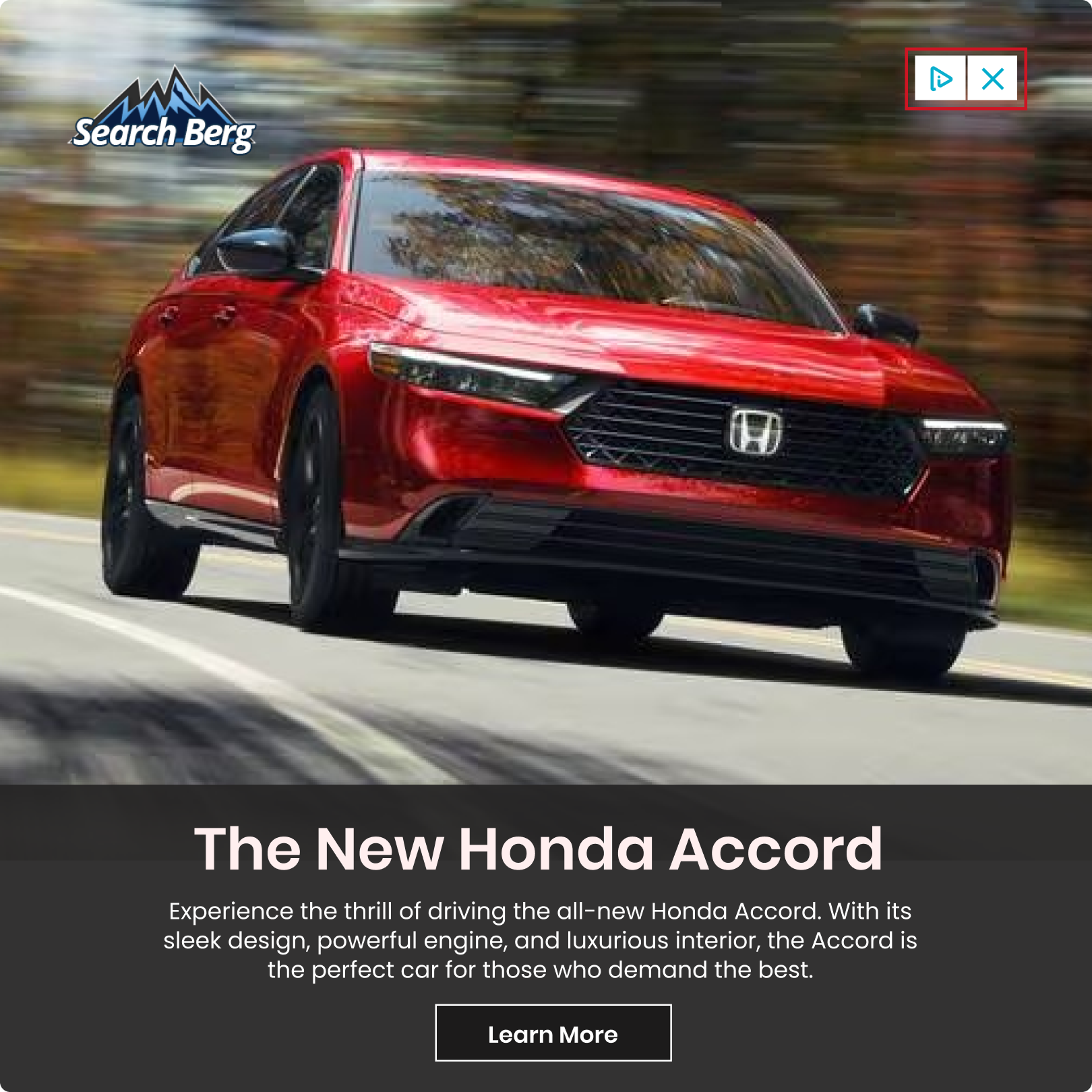
This is a classic example of a display ad, likely found on a website or app related to cars, lifestyle, or general news. It uses a striking visual combined with concise and persuasive text to capture attention and generate interest in the new Honda Accord.
3. Social Media Ads
Social media isn’t just for sharing selfies and cat videos anymore. It’s a marketing powerhouse! With billions of users scrolling through their feeds every day, social media platforms have become prime real estate for reaching your target audience and achieving your business goals.
And that’s where pay-per-click advertising comes in. Social media ads allow you to laser-focus your message and put it right in front of the people most likely to be interested. Think of it like this: you’re not just buying ads; you’re building relationships, sparking conversations, and turning followers into loyal customers.
But here’s the kicker: each social media platform is unique. Facebook, Instagram, X (formerly known as Twitter), LinkedIn, Pinterest, TikTok… they all have their own quirks, demographics, and ad formats. To succeed with social media advertising, you need to understand these nuances and tailor your strategy accordingly.
Let’s break down some of the most social media pay-per-click advertising options.
- Facebook Ads:Facebook is the king of social media advertising, and for good reason. With its massive user base and incredibly granular targeting options, you can reach almost anyone, anywhere. Want to target new parents in a specific city who are interested in organic baby food? Facebook can do that. You can choose from various ad formats, including image ads, video ads, carousel ads (perfect for showcasing multiple products), and dynamic product ads (which show users personalized product recommendations based on their browsing history).
- Instagram Ads: If your target audience is younger and visually driven, Instagram is your playground. Instagram ads blend seamlessly into the platform’s aesthetic, appearing as stunning image ads, captivating video ads, engaging carousel ads, and ephemeral Stories ads. A fashion brand, for instance, could use Instagram ads to showcase their latest collection with high-quality photos and videos, targeting users interested in fashion, style, and specific influencers.
- X (Twitter) Ads: X is all about real-time conversations and trending topics. X ads can appear in users’ timelines, as promoted trends (think hashtags that are trending), or even as sponsored hashtags. They’re a great way to reach a large audience, generate buzz around a product launch or campaign, and drive traffic to your website. A tech company launching a new gadget could use X ads to target users interested in technology, gadgets, and specific industry publications.
- LinkedIn Ads: LinkedIn is the go-to platform for B2B marketing. Its audience is primarily professionals and decision-makers, making it ideal for promoting B2B products and services. LinkedIn ads can appear in the feed, sidebar, or even in InMail messages (LinkedIn’s internal messaging system). You can target your ads based on job titles, industries, company size, and more. A software company, for example, could use LinkedIn ads to target marketing managers and CEOs at companies with over 100 employees.
- Pinterest Ads: Pinterest is a visual discovery engine, where users go to find inspiration for everything from recipes and DIY projects to fashion and home decor. Pinterest ads, known as “Promoted Pins,” appear in users’ feeds and search results, blending seamlessly with organic content. They’re highly effective for driving traffic to e-commerce websites and showcasing visually appealing products. A furniture company could use Pinterest ads to promote their latest designs, targeting users who have shown interest in home decor, interior design, and specific furniture styles.
- TikTok Ads: TikTok is the rising star of social media, especially among younger audiences. Known for its short-form video content, TikTok offers a unique opportunity to engage users with creative and entertaining ads. TikTok ads appear in users’ “For You” page feeds, where the algorithm curates a personalized stream of content. A music streaming service could use TikTok ads to reach Gen Z users by creating short, catchy videos featuring popular songs and artists.
Example:
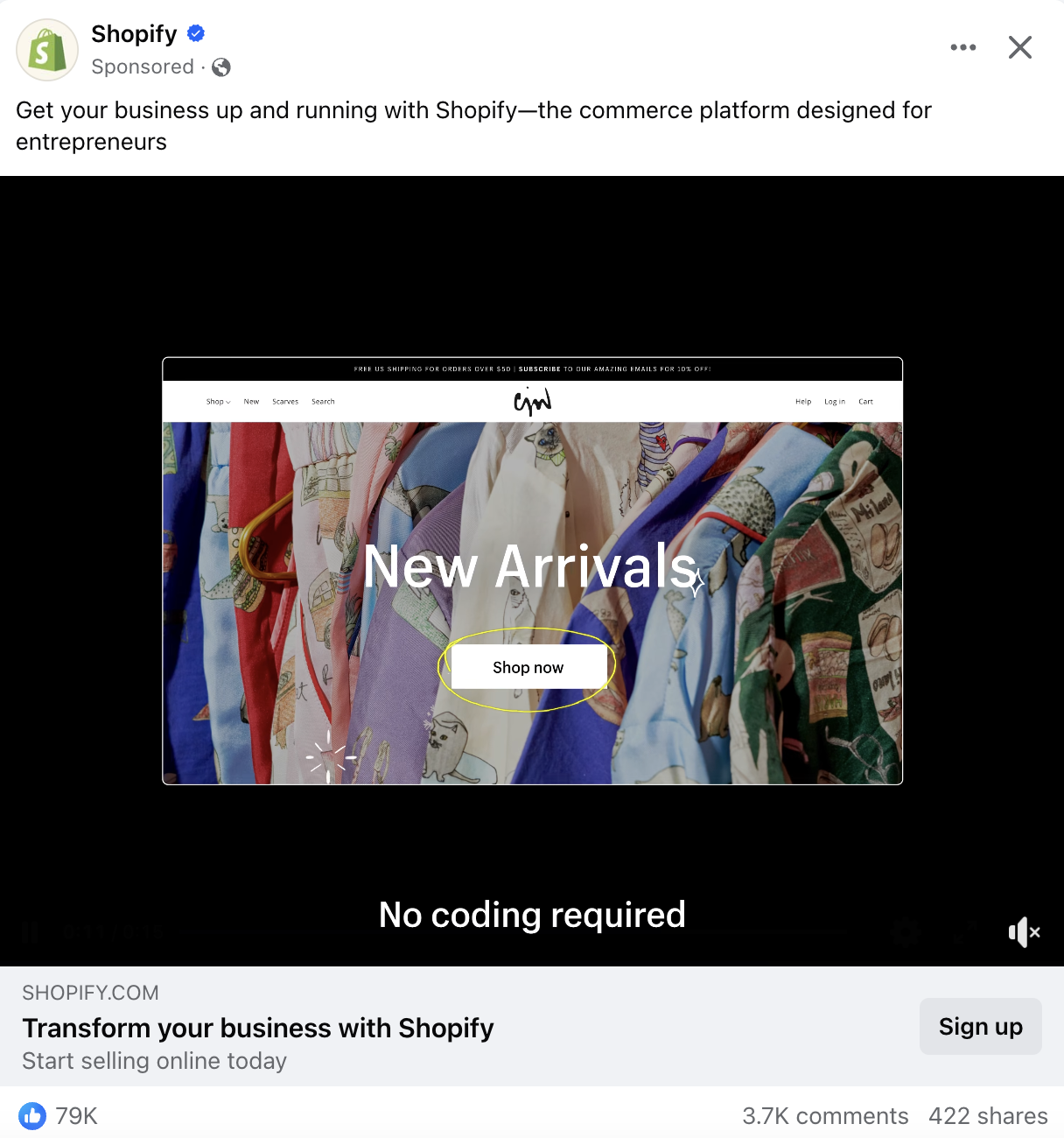
This Shopify Facebook pay-per-click ad is a stellar example of how to effectively use social media advertising to reach your target audience and drive conversions.
The prominent “Sign Up” button (bottom right) makes it easy for potential customers to take the next step. The ad also includes a secondary call to action, “Start selling online today,” which reinforces the message that Shopify can help businesses get started quickly and easily.
This is a masterclass in social media advertising done right.
Recommended Read: How to Create Winning Social Media Strategies for Small Businesses
4. Remarketing Ads
Ever browsed an online store, added a few items to your cart, and then…left without making a purchase? We’ve all been there. But what if those products magically reappeared, following you around the internet like a friendly reminder? That’s the power of remarketing ads.
Remarketing, also known as retargeting, allows you to show targeted pay-per-click ads to people who have previously interacted with your website or brand. It’s like giving those hesitant shoppers a gentle nudge, reminding them of what they’re missing and enticing them to return.
It all starts with a small piece of code called a “pixel” that you place on your website. This pixel tracks visitors’ behavior, allowing you to build audiences based on specific actions they take, such as:
- Visiting specific pages (e.g., product pages, pricing pages)
- Adding items to their cart
- Initiating checkout but not completing the purchase
- Watching a video
- Downloading a resource
Once you’ve created your remarketing audiences, you can show them tailored ads across various platforms, including:
- Google Display Network :Reach your audience across millions of websites and apps.
- Social Media Platforms: Reconnect with potential customers on Facebook, Instagram, Twitter, and LinkedIn.
- YouTube: Show video ads to people who have previously interacted with your YouTube channel or videos.
Example:
You’ve been eyeing that classic Hermès Birkin bag for months. You’ve browsed luxury online retailers, zoomed in on those exquisite details, maybe even added one to your wish list. But the price tag? Let’s just say it requires some serious saving (or a lottery win).
Then, as if by magic, this Facebook pay-per-click ad appears in your feed:
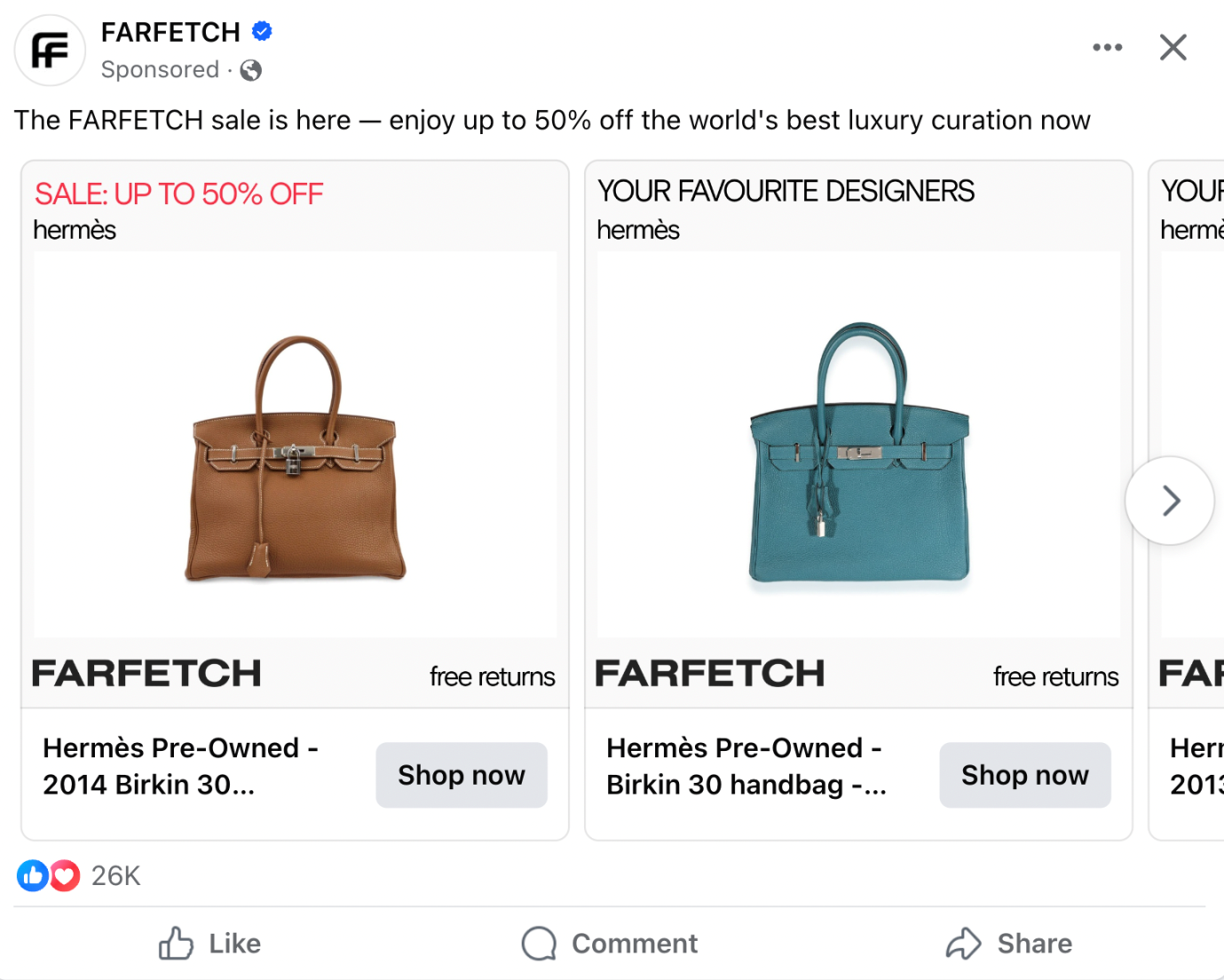
This is remarketing at its finest. By understanding the user’s past browsing behavior and presenting them with a relevant offer at the right time, FARFETCH increases the chances of turning a window shopper into a paying customer.
This personalized approach is key to successful remarketing campaigns. It helps build a stronger connection with the user and fosters a sense of exclusivity and personalized service.
Crafting truly effective retargeting ads requires a deep understanding of consumer behavior, data analysis, and ad platform nuances. Instead of tackling the ropes yourself, opt for professional PPC management services.
Experts in this field can help you segment your audience with precision, tailor your messaging to resonate with their specific needs and interests, and optimize your campaigns for maximum impact.
5. Shopping Ads
In the cutthroat world of eCommerce, grabbing attention is paramount. You’ve got amazing products, but how do you make them stand out in a sea of online retailers?
The answer? Shopping ads.
Think of these ads as the online equivalent of window shopping. They transform boring, text-based search results into a vibrant marketplace, showcasing your products with eye-catching images and essential details right when potential customers are searching for them.
Instead of just seeing a wall of text, users are greeted with a visually rich experience.
Shopping pay-per-click ads feature:
- High-Quality Images: A captivating image of your product is the first thing users see, drawing them in and enticing them to learn more.
- Product Title: A clear and concise product title helps users quickly identify what you’re selling and ensures relevance to their search query.
- Price: Transparency is key! Displaying the price upfront allows users to compare options and make informed decisions.
- Brand: Showcase your brand name prominently to build trust and recognition.
- Other Attributes: Include additional details like color, size, availability, and even special offers to provide users with all the information they need.
Example:
Let’s say a web user is looking for something like “best vacuum cleaners” or “new Dyson vacuum.” They’re not just idly browsing; they have a clear intent to research and potentially purchase a new vacuum cleaner.
Now, instead of being confronted with a wall of text-based search results, they’re greeted with this visually appealing display of Shopping ads.
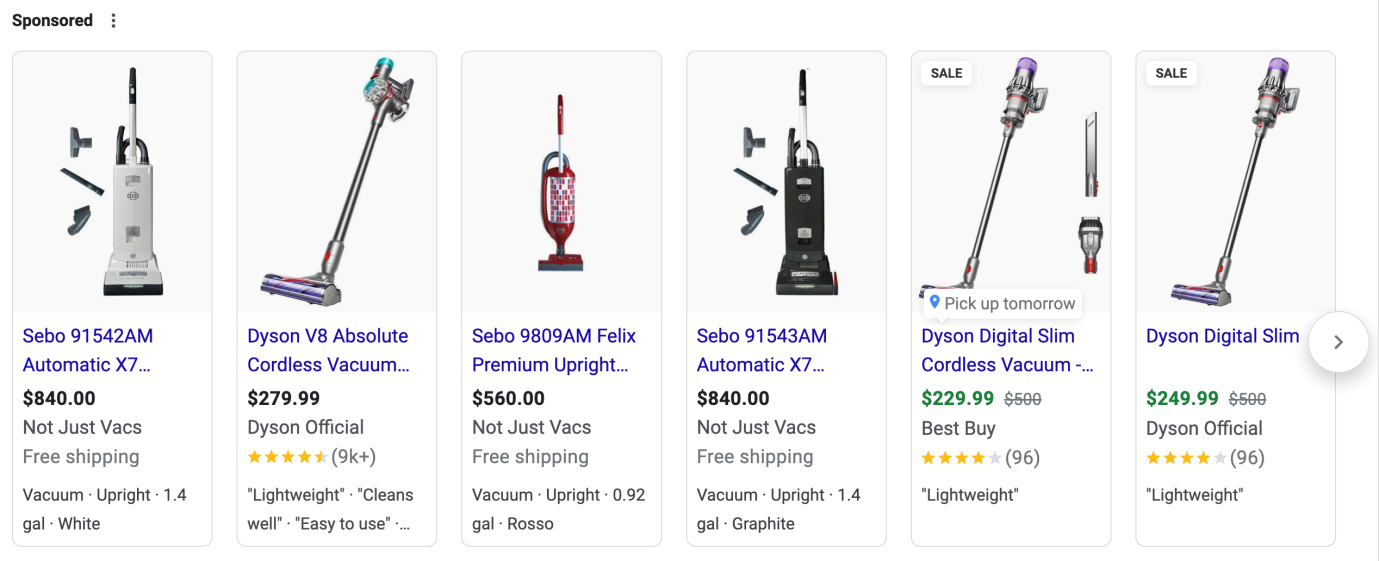
Immediately, they see a variety of vacuum cleaners from different brands, each with a high-quality image that showcases the product’s design and features. This visual presentation caters to the user’s desire to see and compare different options before making a decision.
But it’s not just about the visuals. Each ad provides vital information upfront: the product title clearly identifies the specific model, the price allows for quick comparisons, the brand name builds trust and recognition, and additional details like “Free Shipping” or “Pick Up Tomorrow” add to the convenience factor.
This satisfies the user’s need for detailed information to make an informed choice.
By clicking on any of these PPC ads, the user is taken directly to the product page on the retailer’s website, where they can learn more and make a purchase. This streamlined process eliminates friction and encourages conversions.
This is a prime example of how Google Shopping ads can be a game-changer for eCommerce businesses, boosting visibility, attracting qualified leads, and ultimately driving sales.
6. Gmail Sponsored Ads
Think about how much time you spend in your email inbox each day. Now imagine reaching your ideal customers right there, amidst their daily correspondence. That’s the unique opportunity that Gmail Sponsored Ads offer. These ads appear at the top of the Promotions tab in Gmail, seamlessly blending with the user’s inbox experience.
But don’t worry; they’re not intrusive like spam. Gmail Sponsored Ads are designed to be valuable and engaging, providing users with relevant information and offers. They initially appear in a collapsed format, much like a regular email, with a sender name, subject line, and a small teaser text. When a user clicks on the collapsed ad, it expands into a larger, richer ad unit, which can include images, videos, and call-to-action buttons.
Why are Gmail Sponsored Ads a smart pay-per-click choice?
- Native Advertising: They blend seamlessly into the user’s inbox, providing a non-disruptive advertising experience.
- Targeted Reach: You can target your ads based on demographics, interests, and even keywords that appear in users’ emails. This allows you to reach people who have already expressed interest in topics related to your business.
- Cost-Effective: You only pay when a user clicks on your ad and expands it. This makes Gmail Sponsored Ads a cost-effective way to reach a targeted audience and drive conversions.
What makes these ads so effective? They appear at the top of your inbox, mimicking the look of regular emails, which makes them less intrusive and more likely to be noticed. This native advertising approach helps them blend in with your usual email flow, increasing the chances of you engaging with them.
Recommended Read: PPC Management for Small Businesses: Tips and Tricks
7. Instream Ads
Video has become the dominant force in online content consumption. People are watching more videos than ever before, whether it’s on YouTube, Vimeo, or other streaming platforms. Instream ads allow you to tap into this engaged audience by placing your ads within video content.
These ads come in various formats, each offering unique advantages:
- Pre-Roll Ads: These ads play before the video content begins, capturing viewers’ attention right from the start.
- Mid-Roll Ads: These ads play during the video content, offering a break in the action and a chance to deliver your message.
- Post-Roll Ads: These ads play after the video content ends, leaving a lasting impression on viewers.
- Non-Skippable Ads: These ads must be watched before the video content can be viewed, ensuring your message is seen.
- Skippable Ads: These ads allow viewers to skip after a few seconds, giving them more control over their viewing experience.
For businesses that thrive on video content, instream PPC ads are like a match made in heaven. Let’s say you’re a yoga instructor with a popular YouTube channel filled with instructional videos and guided meditations. Your audience is already engaged, actively seeking out your content. Instream ads allow you to seamlessly integrate your promotional messages within these videos, reaching your target audience precisely when they’re most receptive.
Think of it this way. Your videos are already attracting viewers interested in your niche. Instream ads capitalize on this existing engagement, allowing you to promote your online courses, workshops, or merchandise directly to those who are most likely to convert. It’s like having a captive audience eager to learn more about what you offer.
By strategically placing your ads within your video content, you can nurture viewers towards a purchase or desired action without disrupting their viewing experience.
Instream pay-per-click adsalso offer a unique opportunity to showcase your brand personality and build stronger connections with your audience. You can use these ads to tell your story, highlight your expertise, and build trust with potential customers. Whether it’s a pre-roll ad that introduces your latest offering or a mid-roll ad that provides a valuable tip related to your content, instream ads can seamlessly integrate your marketing messages within the viewing experience, creating a natural and engaging path to conversion.
Example:
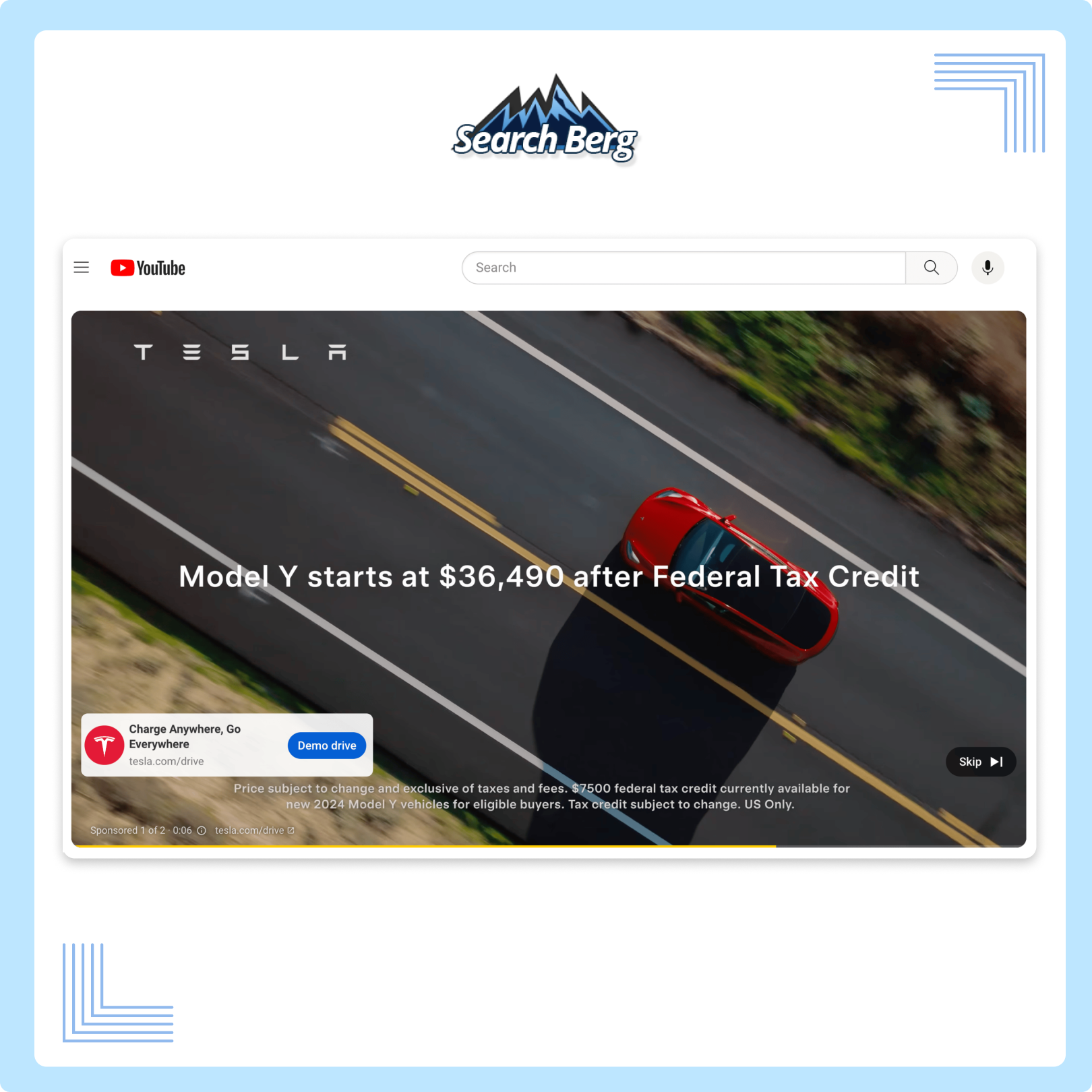
Tesla’s instream ad, showcasing the Model Y, is a masterclass in leveraging video advertising to achieve marketing goals. It’s strategically positioned as a pre-roll ad on YouTube, capturing viewers’ attention before they explore the content they’re interested in.
This placement ensures that the ad reaches a broad audience, including those who may not be actively exploring Tesla but are receptive to new information and captivating visuals.
By combining captivating visuals, concise messaging, and a clear call to action, Tesla’s instream ad effectively captures attention, builds brand awareness, and drives potential customers further down the sales funnel.
It’s a stellar example of how video advertising can be a powerful tool for businesses, especially those like Tesla, whose products are inherently visual and aspirational.
8. Local Service Ads
A potential customer’s faucet is leaking, their AC is on the fritz, or they desperately need a dog walker for their furry friend. They turn to Google and search for “plumber near me,” “AC repair,” or “dog walker in [their city].” Right there, at the very top of the search results, are Local Service Ads (LSAs), a goldmine for businesses like yours.
LSAs are Google’s answer to connecting local businesses with eager customers in their area. They’re designed to be highly visible, trustworthy, and lead-driven. This makes them an essential tool for any business that serves a local community.
What Makes LSAs Unique?
- The “Google Guaranteed” Badge: One of the most powerful features of LSAs is the “Google Guaranteed” badge. This badge signifies that your business has been vetted and approved by Google, instantly boosting your credibility and trustworthiness in the eyes of potential customers. It’s like having a seal of approval from Google itself, giving customers the confidence to choose your business over the competition.
- Prominent Placement: LSAs don’t just blend in with the search results; they stand out. They appear at the very top of the page, above even the traditional search ads. This prime real estate ensures that your business is the first thing potential customers see when they search for relevant services.
- Lead-Driven Focus: LSAs are all about generating leads. When a user clicks on your ad, they’re presented with options to contact your business directly, whether through a phone call, a message, or a booking request. This streamlined process makes it easy for customers to connect with you and eliminates unnecessary steps.
- Pay-Per-Lead Pricing: Unlike traditional PPC ads where you pay per click, with LSAs, you only pay when you receive a qualified lead. This means you’re only paying for actual customer inquiries.
How Do LSAs Work?
You’ll start by creating a detailed profile for your business on Google My Business and the Local Services Ads platform. This profile includes information about your services, service area, hours of operation, and customer reviews.
To earn the coveted “Google Guaranteed” badge, you’ll need to pass a background check and meet Google’s quality standards. This involves providing proof of insurance and licensing, as well as maintaining a high customer satisfaction rating.
You’ll also set a weekly budget based on how many leads you want to receive. Google will then show your ads to potential customers in your area who are searching for your services.
When a customer contacts you through your LSA, you’ll receive a notification and can respond directly through the platform. You can track your leads, manage your bookings, and even request customer reviews to further enhance your profile.
Example:
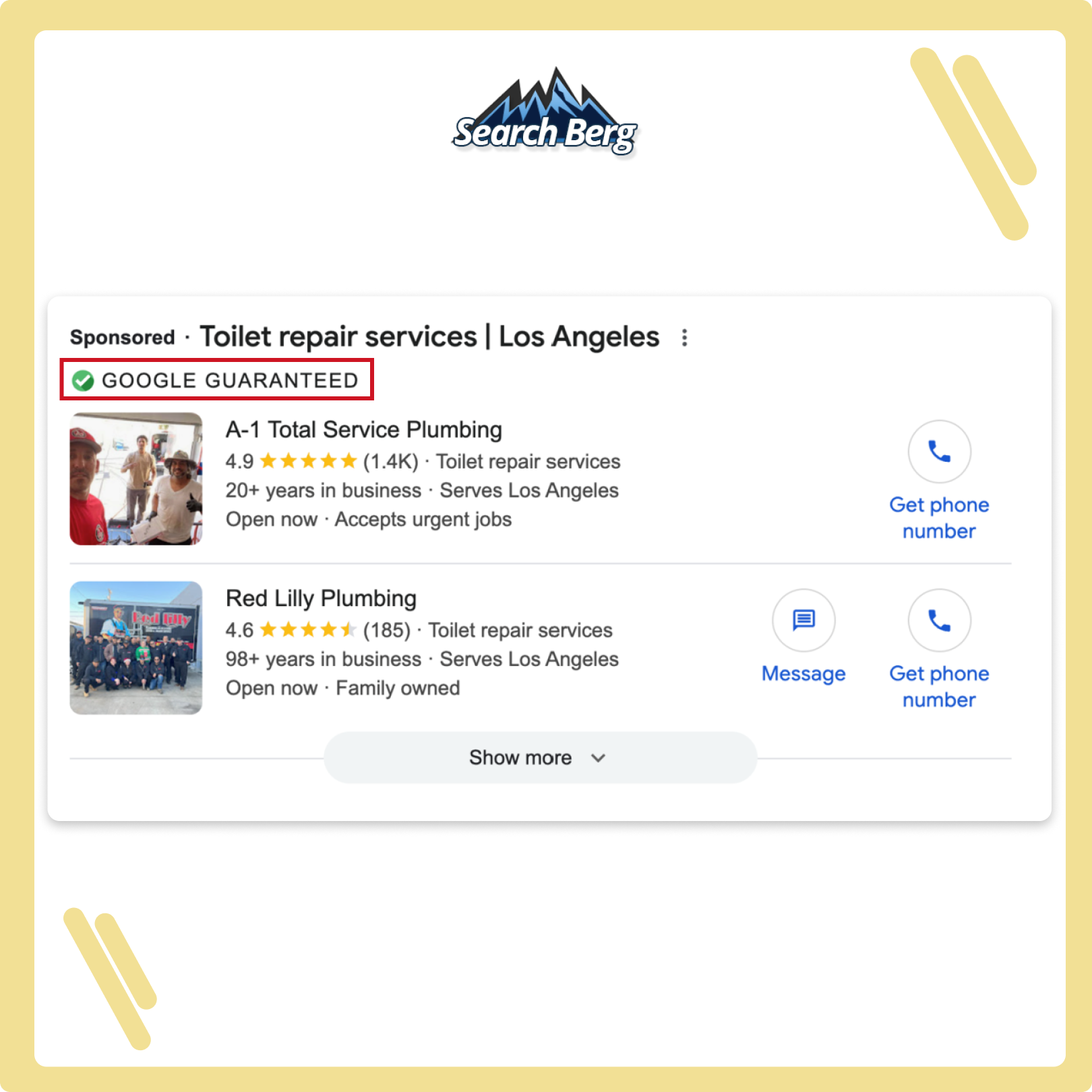
This screenshot perfectly illustrates the power of LSAs for local businesses. These ads dominate the top of the search results page, appearing above traditional search ads and immediately capturing the user’s attention. When someone needs a service urgently, like a toilet repair, they’re likely to click on the first reputable option they see, and these LSAs are strategically positioned to be that option.
The “Google Guaranteed” badge is prominently displayed on each ad, acting as a powerful endorsement from Google and assuring users that these businesses have been vetted and meet Google’s quality standards. This badge instantly builds trust and credibility.
How Can I Set Up Pay-Per-Click Ads?
By now, you’ve got a solid grasp of what PPC ads are, how they work their magic, and why they’re so darn effective. You’ve also seen pay-per-click advertising examples.
But here’s the burning question: how do you actually set up PPC ads? How do you translate all that knowledge into a real-life campaign that drives results?
While the specific steps may vary depending on the platform you choose (Google Ads, Facebook Ads, etc.), here’s a general overview of the PPC setup process:
- Choose Your Platform: Where do your ideal customers hang out online? Google? Facebook? Instagram? Select the platform that best aligns with your target audience and business goals.
- Set Your Goals: What do you want to achieve with your PPC campaign? Drive traffic to your website? Generate leads? Boost brand awareness? Having clear goals will guide your strategy and help you measure success.
- Conduct Keyword Research: Keywords are the foundation of any PPC campaign. Identify relevant keywords that your target audience is searching for, using tools like Google Keyword Planner.
- Set Your Budget: Determine how much you’re willing to spend on your PPC campaign. You can set daily or monthly budgets, and remember, you only pay when someone clicks on your ad (hence the name “pay-per-click”).
- Create Your Ads: Craft engaging, high-quality ad copy that grabs attention, highlights your unique selling propositions, and includes a clear call to action.
- Target Your Audience: Use the platform’s targeting options to refine your audience based on demographics, interests, behaviors, and other criteria.
- Set Up Your Landing Page: Ensure your landing page is relevant to your ad and optimized for conversions. It should provide a seamless user experience and encourage visitors to take the desired action (e.g., make a purchase, fill out a form).
- Track and Optimize: Monitor your campaign performance closely, analyze the data, and make adjustments to improve your results. This might involve tweaking your ad copy, adjusting your bids, or refining your targeting.
The Need for Pros
While the steps above may seem straightforward, setting up truly effective PPC campaigns requires more than just following a checklist.
It demands a deep understanding of:
- Consumer Psychology: What motivates people to click on an ad? What are their pain points, desires, and aspirations?
- Marketing Fundamentals: How do you create a compelling message that resonates with your target audience? How do you craft a strong call to action that drives conversions?
- Data Analysis: How do you interpret campaign data to identify areas for improvement? How do you optimize your campaigns for maximum ROI?
This is where the expertise of PPC management experts comes into play. They can provide the strategic guidance and tactical execution needed to create high-performing PPC campaigns.
Why Search Berg?
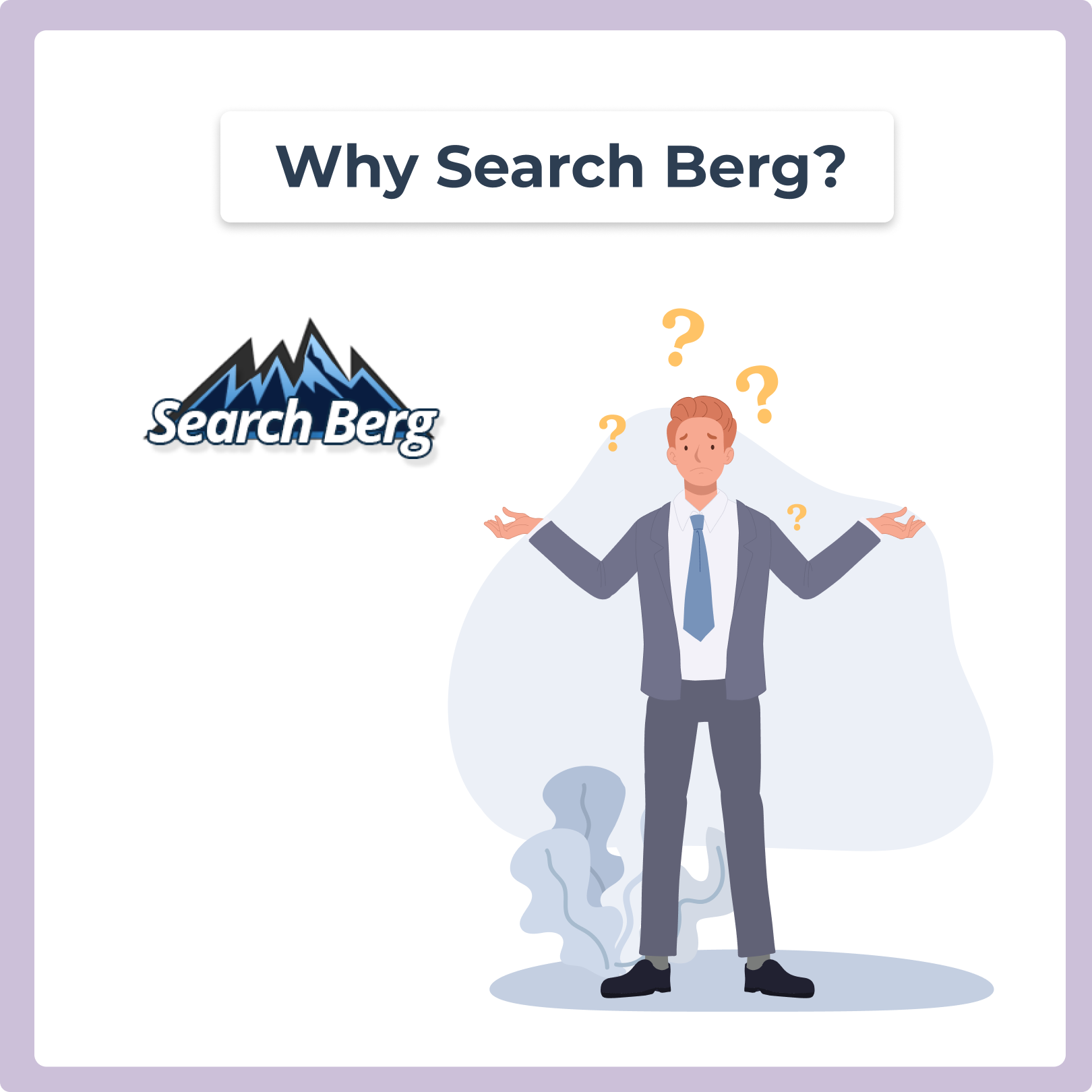
At the Search Berg headquarters, we don’t believe in vanity metrics. We’re laser-focused on driving conversions, generating leads, and boosting your bottom line. We meticulously track every click, every conversion, and every dollar spent, ensuring that your PPC campaigns deliver a tangible return on investment.
The world of PPC is constantly evolving, and we’re committed to staying ahead of the curve. We’re always exploring new strategies, testing new technologies, and refining our approach to ensure our clients get the best possible results.
Our Services:
- PPC Campaign Management: From keyword research and ad creation to bid management and performance tracking, we handle every aspect of your PPC campaigns,freeing you to focus on what you do best.
- Landing Page Optimization: We ensure your landing pages are optimized for conversions, providing a seamless user experience and encouraging visitors to take action.
- PPC Audits: We analyze your existing PPC campaigns and identify areas for improvement, providing actionable recommendations to boost your performance.
- PPC Consulting: We provide expert guidance and support to help you develop a winning PPC strategy, whether you’re just starting out or looking to take your campaigns to the next level.
Turn to PPC management experts who know exactly what they’re doing.
Our PPC management services start with a free consultation, no commitment. We take the time to understand your business, your goals, and your challenges, and then develop a customized PPC strategy designed to deliver exceptional results.
Let’s get started!
Ready to Launch Your Own High-Converting PPC Campaigns?
Don’t let your competitors outrank you! Partner with PPC management experts who can help you create targeted, profitable PPC campaigns that drive real business growth. Contact us today for a free consultation and let’s discuss your advertising goals.
No spam, just expert advice!












